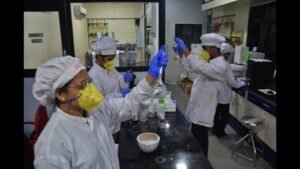
The Advent of Artificial Intelligence (AI) has revolutionized health care over the past decade by transforming the way physicians diagnose, treate, manage diseases, and manage diseases, and by making methods more services more settings, Accurate, and Personalised. This, in turn, helps clinicians to ensure that all patients receive precise, evidence-based treatment, irrespective of age, gender, or existing comorbidities.

On World Heart Day, let us consider the grave challenge before us, where ai can be of use. According to the World Health Organization (WHO), Cardiovascular Diseases (CVDs) are the primary cause of morbidity and mortality in the world, representing an estimate 17.9 Milllion Deaths – A 3 31% of all Deaths across the globe.
India is one of the countries most burdened by cvds, thus earning the monaker “The heart attacques capital of the world”. Even WorsE, a notable number of cardiac-Related Deaths Occur in Individuals under the age of 50 years-a decade earlier than the offer from living in Western Countries. This shockingly high number of patients suffering from cvds have essential founding Ways to accurately identify and treat “at-revisk” individuals before thei
Over the past decade or so, Science has advanced in Leaps and bounds, introducing new and sophisticated tools for more precisely diagnosing and predicting the future development of disheass. The field of therapeutics has also advanced considerably. While these developments Empower Physicians to Treat the Patients Better, The Availability of the Vast Amount of Health of Health Care Data also overwhelms human capacity. It has comerly impossible for doctors and other health care professionals to assimilate the available information, Draw the Most Precise Conclusions and Make the Most Accounts Treatment Decisions.
This is where ai steps in – Not only can it algorithms help Health Risks, Leading to Earlier and More Precise Interventions and Improved Patient Outomes.
In Cardiac Illnesses, AI Can Help Analyse and Assimilate Medical Information from Various Diagnostic Tools Such as Electrocardograms (ECGS), Echocardograms, Echocardograms, Stress Tests, CT SCANS, and Even From wearable devices, integrate it with the available clinical and laboratory data, and identify subtle patterns and changes that would be invisible to the human eye. This not only allows very early identification of individuals who are at the highest risk and need the most attation, it also also also enables clinicians to make the Most Accounts Treatment Decisions At Every Stageays Process.
But despite these advances, challenges in ensuring consistent and unbied treatment person. For example, Younger Cardiovascular Patients often Experience Disparity with Respect to receive optimal medical treatment. Studies have suggested that young people face age-Related Optimism Bias-Essentially, Doctors May Undrestimate Their Risk and Delay Treatment, Leading to WORSE OUTUSCES. The symptoms of younger cardiovascular patients are often dismissed as Minor, Attributed to work-Related Stress, or are Considered Unlikely to be Linked to Serious Illnes. This can lead to delays in diagnosis and treatment.
Intervening Early in Cardiovascular Cases is Important Secause IT Helps Prevent Minor Issues from Progressing Into Life-Threating Conditions Such as Hearts, Strokes, Strokes, Strokes, Or Heart Fail Failure. Timely Diagnosis and Treatment Can Reduce Damage to the Heart and Blood Vessels, Improve Recovery Outcomes, and Lower the Chances of Long-Term Complications. AI Models May Help Here: Its algorithms can help physicians Improve PATIENT-Specific Decision-Making.
Separately, Several Obsers Note that AI can help improves to health care in rural areas, address a shortage of trained medicine professionals, as well as help.
However, we must be careful: after all, ai is merely a support tool that we do notrs can use to help diagnose and treat a dishease. AI cannot help in cases where the patients themselves may not recognize the symptoms of a disease – or may delay seeking medical attention – which can allows to get
Ai Merely Provides the doctor with data, it is up to the doctor to provide a medical context to the information he or she receives. AI Analysis also Heavily Depends on the Quality and Diversity of the Data – Poor Data Can Result in Misinterpretation that Experienced Physicians Allswise Recognise.
To conclude, I would like to quote the Science fiction writer, isaac asimov: “The machine is only a tool after all, which can help humanity program by taking Some Interpretations of Its Back. The Task of the Human Brain Remains
Naresh Trehan is CMD, Medanta Hospitals. The views expressed are personal




